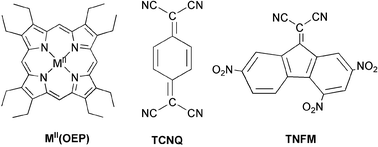Crystals of C60·PtII(OEP)·2(C6H6), TCNQ·CuII(OEP), TCNQ·H2(OEP), TCNQ·2CuII(OEP), TCNQ·2ZnII(OEP) and TNFM·CoII(OEP) [OEP is the dianion of octaethylporphyrin, TCNQ is 7,7,8,8-tetracyanoquinodimethane, TNFM is (2,4,7-trinitrofluorenylidene)malonitrile] have been obtained by diffusion of a solution of the porphyrin as donor into a solution of the respective acceptor molecule. The structure of C60·PtII(OEP)·2(C6H6) consists of an ordered C60 cage nestled against the platinum porphyrin which makes close face-to-face contact with another PtII(OEP) molecule. In contrast, there are no close face-to-face contacts between porphyrins in the crystal structures of TCNQ·CuII(OEP), TCNQ·H2(OEP), and TNFM·CoII(OEP). These compounds consist of classical donor–acceptor stacks of interleaved porphyrin and TCNQ or TNFM molecules with separations of ca. 3.3 Å between adjacent molecules. However with TCNQ·2CuII(OEP) and TCNQ·2ZnII(OEP) the structures involve TCNQ (A) and MII(OEP)
(D) molecules that crystallize in stacks with a DDA(DDA)nDDA arrangement. Within these stacks there are pairwise contacts between MII(OEP) molecules and these pairs are compared to those found in C60·PtII(OEP)·2(C6H6) and related fullerene-containing crystals.

You have access to this article
 Please wait while we load your content...
Something went wrong. Try again?
Please wait while we load your content...
Something went wrong. Try again?


 Please wait while we load your content...
Please wait while we load your content...